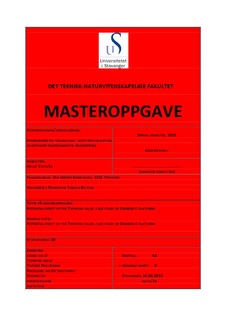| dc.description.abstract | Onshore and offshore facilities produce oil and gas worldwide. Globally, the daily oil production reached 83.6 million barrels per day in 2011. During the following years the production has continued increasing.
It was estimated that the amount of water produced were over 210 million barrels per day in 1999. Thereby averagely in a global aspect 3 barrels of water had to be produced per barrel of oil. In 2005, 67-72% of all oil produced was produced from mature fields, also called brown fields. These brown fields were believed to hold the majority of the oil resources and production capacity.
All produced water should be treated before it is discharged or re-injected to a reservoir. The level, of which the produced water has to be cleaned before discharge, depends on the regions environmental regulations. At the Norwegian continental shelf environmental regulations for discharged produced water are determined by the Norwegian Environmental Ministry and OSPAR. OSPAR has an average minimum demand that OiW (oil in water) concentration shall be less than 30 ppm in average, and a maximum discharge can be 49 ppm. The Norwegian Environmental Ministry has stricter environmental demands, requiring further reduction of both OiW and hazardous components.
Produced water treatment is usually carried out in different steps that use different enhanced separation techniques. Statoil ASA has an internal demand that a produced water treatment system shall always have two or more different separation enhancing techniques, to make it more resistant for system upsets. The most standard setup is to have hydrocyclones downstream the main separators that use enhanced gravitational separation and some kind of flotation unit downstream the hydrocyclones. A flotation unit increase separation by enhancing the density difference between oil and water.
Typhonix, a local company in the Stavanger region, has developed a low shear valve that has a positive effect on separation systems compared to standard valves. For the produced water, benefits by using typhoon valve have been observed to be a reduction of OiW. Other potential benefits are assumed to be reduction in WiO (water in oil), less need for production chemicals and generally better separation performance in downstream equipment.
Most of the typhoon valve test data has been obtained at laboratory conditions. In 2011 the valve was tested with real conditions and compared with a standard valve at Oseberg C. Positive results were also provided from the Oseberg C test.
In this report a case study of Oseberg C will be carried out. The objective will be to reveal if there will be overall benefits on the platform if all choke valves were replaced by typhoon valves. The study will be based on the typhoon valve pilot test at Oseberg C, other typhoon tests, theory about process units and consulting with process personnel from several oil companies. Some conclusions about the process system on Oseberg C have been made:
• The main gravity separators efficiency is increased when typhoon valve is installed compared to when a standard valve is installed. Increase in efficiency was observed as a reduction in OiW concentration by 55%.
• Hydrocyclone relative efficiency has been proven to be independent of feed OiW concentration as long as the droplet size is the same.
• Degasser relative efficiency has been proven to have some reduced performance when OiW concentration is reduced. The relative efficiency reduction increase when the amounts of OiW reduction increase.
A theoretical case study has been carried out on the platform to find what the total effect by changing standard valves with typhoon valves would be. This was done by using the knowledge obtained about the process system at Oseberg C and the reaction the system would have on an OiW reduction of 55%. The conclusions from the case study are:
• In this case a 55% reduction of OiW out of the separators will cause the OiW concentrations at the discharge point to be reduced by 55%. Causing oil discharged to sea to be reduced from 7.70 ton to 3.45 ton per year.
• The reduction of OiW out of the separator has the potential to reduce the amount of flocculants used by 55%, because flocculent dosing is dependent on OiW concentration. This reduction is equal to 36.7 – 110 ton of flocculent.
• The produced water system is believed to have a better buffering capacity for system upsets because the OiW concentration in the discharged water is generally lower.
• The positive effects from the typhoon valves are believed to be lowest at 50% water-cut. From valve tests conducted before this work, the benefits by applying a typhoon valve have increased when water-cuts were different from 50%. During the pilot test at Oseberg C the water-cut were close to 50%. Considering this, the typhoon valve is assumed to at least perform according to the results obtained in this work. | no_NO |
